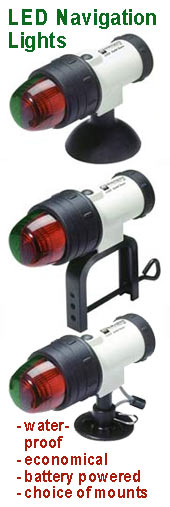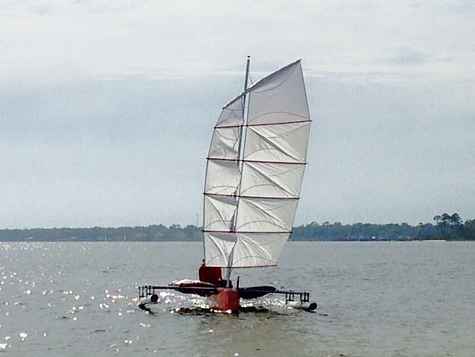
 Custom Search
|
| boat plans |
| canoe/kayak |
| electrical |
| epoxy/supplies |
| fasteners |
| gear |
| gift certificates |
| hardware |
| hatches/deckplates |
| media |
| paint/varnish |
| rope/line |
| rowing/sculling |
| sailmaking |
| sails |
| tools |
| join |
| home |
| indexes |
| classifieds |
| calendar |
| archives |
| about |
| links |
| Join Duckworks Get free newsletter CLICK HERE |
|
|
| Little Tri Sailboat |
by Mike Mangus
- Columbus, Mississippi - USA |
Designed by Bernd Kohler and Hull #3 Built By Mike Mangus2014 was an eventful year with two rookie sailing trips (Florida 120 and the Texas 200) in a Holder 20 boat. Both trips were a blast though a little limited by the Holder's relatively deep drop-keel draft and shallow intercoastal waters. The Holder also suffered from a tight cabin area for two adults trying to camp in. I needed a shoal draft boat with camping capabilities for unlimited exploration fun during the 2015 trips! So the Holder was sold to fund a homebuilt boat. The original plan was to build a Duo 480 biplane rigged catamaran designed by Bernd Kohler. The Duo 480 is a neat 15.5' cabin cruiser. The downside was the 300+ hours of construction that would need to be completed before May 2015's Florida 120. I looked at other designs to see if there was something that fit my vision of a shoal draft cruising boat while keeping the construction hours within a reasonable goal. Then out of the blue Bernd suddenly posted pictures and video of his newest creation, the Little Tri. I immediately saw the potential as a shoal draft boat. Touting 100 hours of build time, the Little Tri could be built quickly over the winter. The cockpit is large enough for a single camper with side trampolines possibly adding two more 6.5' long berths. With the reportedly low cost of materials, I was sold. Plans were purchased. As a first time boat builder with a few decades of scratch building models, I was confident building the Little Tri was within my capabilities. After all, isn't it just a much bigger model boat? When scratch building, I tend to lay out and cut all the pieces before putting it all together. The crisp CAD-drawn Little Tri plans were carefully consulted. All the measurements were in metric but that was fine with me. Some adjustments were required to use Imperial sized wood, such as jockeying the layouts on the plywood due to shorter length sheets and using ¾" square stringers in place of 18-20mm square stock. All throughout the build decisions like these had to be made. The plans are wonderfully drawn for the most part. One thing I did not like was the side panel measurements. There wasn't any. The side panel drawing stated that the builder was to physically measure the drawing's lines on paper and transfer to the wood. Considering things like different paper sizes, printer settings, automatic resizing, etc, it seemed an imprecise way of laying out the side panels. Other than the side panels, the rest of the plan set measurements were precisely annotated down to 1 mm. As a comparison, the Duo 480 side panel drawing has the measurements annotated at every hull station. In all fairness though I was one of the first people to buy the Little Tri plans right after they became available. NOTE: After receiving feedback, Bernd has indicated that he will add the measurements to the side panel drawing. A few weeknights of labor found the bulkheads, keel, and side panels cut and shaped. The next weekend (an extended holiday weekend) had the hull dry assembled in the garage. Bernd's method of assembling a hull is called "matched hole". It is similar to the stitch and glue method where instead of wire, small flathead wood screws are used to hold the pieces together. The matched hole method is very precise and allows for a rigid self-aligning hull while being glued together. Once assembled, the screws are removed and the holes filled in. The build progresses over the next few months. Some deviations from the plan include adding various hatches to the hull for lightweight gear storage. The stern, under cockpit, and compartment directly ahead of the cockpit are spacious for such a narrow hull. A small hatch is added on the deck for the far forward compartment to facilitate air drying the boat if needed. Another deviation is moving the mast position aft to just inside the cockpit. This was necessary for the split junk rig earmarked for the boat. Like Bernd, I had problems tracking down appropriate sized aluminum tubing and PVC pipe for the outriggers. For a short time I thought the cross beams would have to be spliced together. Luckily, a nearby distributer is found that could supply Schedule 40 6063-T6 aluminum pipe in 20' lengths. Unfortunately, that luck did not extend to the 6" diameter PVC pipe for the outriggers. The plans call for 4 meter (13') lengths. The best I could do was 10' lengths locally and shipping for longer pieces actually cost more than the PVC pipe itself! Three 10' long lengths are purchased, cut, and spliced together to the correct length. An internal sleeve was used inside the pipe at the splice and the entire joint wrapped with a layer of fiberglass for rigidity and leak prevention. The method for building the rudder and dagger board is unique. Instead of a solid piece of shaped wood, the rudder and dagger board are made much like an airplane wing with a stressed wood skin curved over a central spar. The build manual is thorough on how to build a jig to hold the pieces together and step by step construction of each board. The end result is a lightweight yet very strong board with an efficient foil shape. The foils get a lot of favorable comments from fellow sailors. I deviated from the plans by adding an extra 4mm width to the leading edges for a blunter stall-resistant foil shape. Additionally, I found out that some hardwood plywoods are simply too stiff to bend without breaking. More flexible plywood was successfully used. Months of short weeknights passed where all the pieces were put together and painted, giving us a rather nice looking hull with the outriggers mounted. By this time, the Florida 120 trip was a month away and the boat still needed a rig. The prototype Little Tri used a Sunfish rig. While that works, I wanted something different and easier to single-hand while sailing in 20+ MPH winds normally found on the Texas 200 event. Junk rigs are known to be easy to handle with quick reefing and other advantages over conventional sloop rigs. The split junk rig I selected addresses the shortcomings of normal junk rigs while keeping the many advantages. It took a month to build the junk sails and rig the boat - just in time for the Florida 120. I do mean just in time too! A mistake in accounting for mast height months previously reared up and bit me the weekend before the trip; the mast was too short! So two days before loading up for Florida found me scrambling to procure longer aluminum pipe for a new mast. Luckily, the somewhat local metals warehouse had some in stock. A few days after Mother's Day, the Little Tri was disassembled and loaded up on top of my compact truck for the five hour trip to Gulf Shores, FL to participate in a Florida group sail. Although a longish boat, its light 220 pounds total weight did not stress the truck at all and saved the cost of a trailer to haul it. All the pieces fit neatly on top of the truck. Rigging at the ramp takes an hour for the first time, with the cross beams and outriggers lashed tightly to the hull with rope. The unstayed mast drops in easily by one person and the sail hung. The entire boat is rolled down the ramp on a four wheeled dolly. Splash! It floats! Sailing the next few days really highlights the boats sailing characteristics in conditions ranging from light and smooth to rough and windy. Light wind sailing is relaxing and smooth with the stable boat gliding over the water. I spent the time kicked back in the 7' long cockpit admiring the views and enjoying the sail. On the second day we get winds starting at 10 mph and climbing to 18 with gusts over 20+. Here the Little Tri really comes alive! It barrels along through rough water with the wave piercing type bow cutting through waves. On the big waves the light weight Little Tri rides over the top without any fuss. The best part of the day is sailed in the relatively smooth water in the lee of the barrier islands while on a stiff port beam reach. Sitting on the port tramp to keep the boat level, we (the Little Tri and I) really move out! Although the wind is blowing, the boat is stable, responsive, and light on the tiller. Other notable features of the boat are the cassette style rudder assembly. With the open back cassette and bungeed in, the rudder simply tilts out when hitting something like a beach. The side daggerbox and daggerboard assembly works just as well. The one time I grounded in shallow water, the daggerboard simply rotated forward in the box and automatically popped up to clear the bottom. Overall, the Little Tri is an easily built boat using common materials such as plywood, aluminum tube, and pvc pipe. Engineered for straight and true building, even a person with little experience (such as myself) can build the Little Tri in approximately 100 hours. Sailing characteristics are forgiving and range from relaxed cruising to sprightly breezy performance. Design features such as cassette rudder, side daggerboard and box, displacement capacity for two large adults, and enough flotation volume to be unsinkable stand out for a small quick-build trimaran. I'd say Bernd nailed this one perfectly. :-)
|
To comment on Duckworks articles, please visit one of the following:
|
 |




